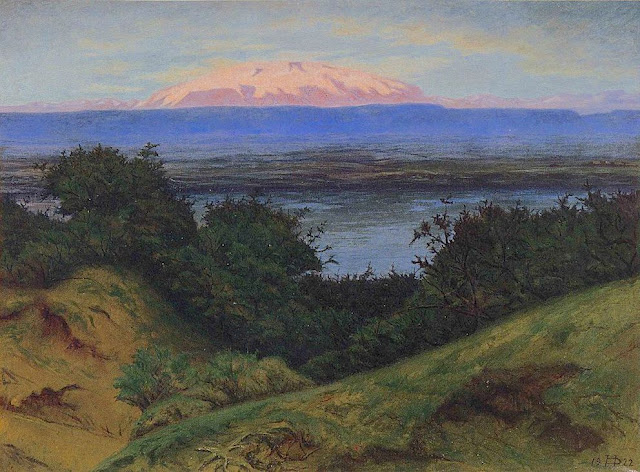ÞORANINN B. ÞORLAKSSON (1867-1924)
Hekla (1,488m - 4,882ft)
Iceland
In Hekla ur Laugardal, 1922, oil on canvas
The mountain
Hekla or Hecla (1,488m - 4,882ft) is a stratovolcano in the south of Iceland. Hekla is one of Iceland's most active volcanoes; over 20 eruptions have occurred in and around the volcano since 874. During the Middle Ages, Europeans called the volcano the "Gateway to Hell".Hekla is part of a volcanic ridge, 40 km (25 mi) long. The most active part of this ridge, a fissure about 5.5 km (3.4 mi) long named Heklugjá, is considered to be within Hekla proper. Hekla looks rather like an overturned boat, with its keel being a series of craters, two of which are generally the most active.
The volcano's frequent large eruptions have covered much of Iceland with tephra, and these layers can be used to date eruptions of Iceland's other volcanoes. Approximately 10% of the tephra created in Iceland in the last thousand years has come from Hekla, amounting to 5 km3. Cumulatively, the volcano has produced one of the largest volumes of lava of any in the world in the last millennium, around 8 km3.
The earliest recorded eruption of Hekla took place in 1104. Since then there have been between twenty and thirty considerable eruptions, with the mountain sometimes remaining active for periods of six years with little pause. Eruptions in Hekla are varied and difficult to predict. Some are very short (a week to ten days) whereas others can stretch into months and years (the 1947 eruption started 29 March 1947 and ended April 1948). But there is a general correlation: the longer Hekla goes dormant, the larger and more catastrophic its opening eruption will be.
The most recent eruption was on 26 February 2000.
Hekla is a popular destination for hiking. Following the most recent eruption the path goes most of the way to the summit; the walk takes 3 to 4 hours. In spring, skiing is possible on short routes around the rim of the crater. In summer, there are easy (F) mountaineering routes also around the crater rim, and it is possible to snowcat to the top in winter. The volcano can be reached using the buses to Landmannalaugar 30 km further east, and it is possible to stay or camp at farms in the area. A visitor centre, The Hekla Center at Leirubakki Farm, opened in 2007.
The Painter
Þóуrarinn Benedikt Þorlбksson was one of Iceland's first contemporary painters, the first Icelander to exhibit paintings in Iceland, and recipient of the first public grant that country made to a painter.
He was born in 1867, the 13th of 14 children of a clergyman father, who died when he was just five years old. Originally trained and working as a bookbinder, Þorlбksson studied painting under a Copenhagen-trained Icelandic woman, Thуra Thoroddsen. In 1900 he was awarded a grant by the Icelandic Parliament to study art in Denmark, and he trained there from 1895 to 1899. Returning to Iceland, he held an exhibition of his works at a place perplexingly called Glasgow, in Reykjavik, in the summer of 1900—the first exhibition of Icelandic painting in Iceland. Þorlбksson's principal interest was landscape painting, and perhaps fittingly a dominant subject in this first exhibition of works was Þingvellir, a site of enormous historical significance to Icelanders as the site of their parliaments (which dated back to 930 AD).
Þóуrarinn Þorlбksson continued to paint, holding regular exhibitions until 1911. However, he required a regular income that could not be derived solely from his art. On December 30, 1913, he was appointed by Prime Minister Hannes Hafstein as one of the five people on the committee that designed the Flag of Iceland. He taught drawing at the Technical College and other institutions in Reykjavik, and was principal of that college from 1916 to 1922. He also ran a shop selling art materials, journals and books until his death. Throughout his life he continued to paint, particularly in the countryside during the summers.
Þorlбksson, together with a small number of other artists including his contemporary Asgrimur Jonsson, confronted and portrayed the landscape of their country on its terms and through Icelandic eyes, rather than through the conventions—and the light—of Western European artistic tradition. In this respect the work of Þorlбksson and Jonsson played a role similar to that of the Heidelberg School in Australia (slightly earlier) and the Group of Seven, Emily Carr and Tom Thomson in Canada (a little later).
2017 - Wandering Vertexes...
by Francis Rousseau
2017 - Wandering Vertexes...
by Francis Rousseau
